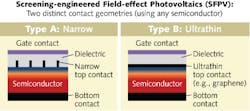University of California–Berkeley and Lawrence Berkeley National Laboratory (LBNL) researchers have developed a technology that could turn any semiconductor material into a photovoltaic (PV) device, in effect putting bad (and perhaps inexpensive) materials to use. The research broadens the potential for developing low-cost PV devices from earth-abundant, nontoxic semiconductors such as metal oxides, sulfides, and phosphides.
The screening-engineered field-effect photovoltaics (SFPV) technology leverages the electric-field effect in which the concentration of charge carriers in a semiconductor is altered by an applied electric field. Using only electrode and gate deposition (rather than high-temperature, expensive, and damaging chemical doping or ion implantation), a geometrically structured partially screening top electrode allows the electric field to penetrate the electrode and modulate the semiconductor carrier concentration and type, inducing a p-n junction.
In a copper oxide structure (Type A), the electrode contact was shaped into narrow fingers; in another configuration with silicon (Type B), the top contact was single-layer graphene. Both create high-quality p-n junctions. Other tailored variations could turn virtually any semiconductor into a PV device. Contact Alex Zettl at [email protected].

